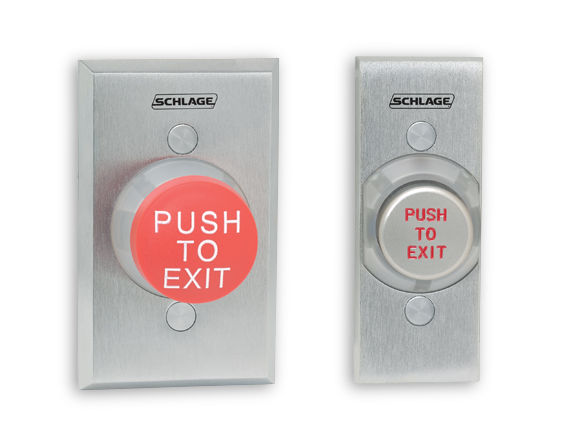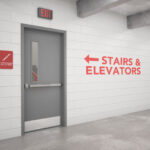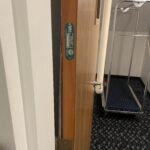 I have a question that I’m hoping you’ll share your insight on, but first…a little background.
I have a question that I’m hoping you’ll share your insight on, but first…a little background.
When an access control application uses a sensor detecting an approaching occupant to release a lock for egress, the model codes require an auxiliary push button which will also release the lock. This type of system is often used with electromagnetic locks, and the codes also require the locks to release upon actuation of the fire alarm/sprinkler system, and upon power failure. This application is the only one where the model codes require an auxiliary switch beside the door – the switch is not required for doors with controlled access/free egress, delayed egress, controlled egress, or mag-locks released by a switch in the door-mounted hardware (local codes may vary).
With regard to the auxiliary switch, the International Building Code (IBC) says this:
The doors shall be arranged to unlock from a manual unlocking device located 40 inches to 48 inches (1016 mm to 1219 mm) vertically above the floor and within 5 feet (1524 mm) of the secured doors. Ready access shall be provided to the manual unlocking device and the device shall be clearly identified by a sign that reads “PUSH TO EXIT.” When operated, the manual unlocking device shall result in direct interruption of power to the electric lock—independent of other electronics—and the electric lock shall remain unlocked for not less than 30 seconds.
NFPA 101 – Life Safety Code says this:
Door locks shall be arranged to electrically unlock in the direction of egress from a manual release device complying with all of the following criteria:
(a) The manual release device shall be located on the egress side, 40 in. to 48 in. (1015 mm to 1220 mm) vertically above the floor, and within 60 in. (1525 mm) of the secured door openings, except as otherwise permitted by 7.2.1.6.2(3)(c).
(b) The requirement of 7.2.1.6.2(3)(a) to locate the manual release device within 60 in. (1525 mm) of the secured door opening shall not apply to previously approved existing installations.
(c) The manual release device shall be readily accessible and clearly identified by a sign that reads as follows: PUSH TO EXIT.
(d) When operated, the manual release device shall result in direct interruption of power to the electrical lock — independent of the locking system electronics — and the lock shall remain unlocked for not less than 30 seconds.
These requirements are clear regarding the location of the switch, that the switch must be marked “PUSH TO EXIT,” and that the switch must be readily accessible (not behind a break-glass panel). These sections also state that the switch must directly interrupt power to the lock – independent of the other electronics – and must remain unlocked for at least 30 seconds.
So here’s the question. One of the ways to accomplish the 30-second unlocking – independent of the access control system electronics – is to use a pneumatic switch. But the model codes don’t specifically prescribe the type of switch that must be used.
What types of switches have you successfully used in these access control systems? Only pneumatic switches, or have other types been acceptable to the AHJ? What are the advantages/disadvantages to the types of switches that may be used?
WWYD?
You need to login or register to bookmark/favorite this content.





Ok some reason I cannot comment off my Iphone.
Anyway, I wish the push button allowance would go away, and either just get rid of it, or go to a electronic touch bar or similar, or sensor.
The push button has been around to long, gets hidden, or placed where not noticeable, or a person not aware of the button release cannot get out of the door.
In this part of the world we use a plastic-covered disconnect switch called a “break glass” that must be reset with a tool. Using it sends an alarm to whoever is monitoring the system. They visit the door, see what went wrong, and then reset the switch. I’m not a big fan of the break glass concept, but it doesn’t seem logical to reset the lock automatically in 30 seconds either. If the PIR is broken, which is a common problem, it should be replaced before locking the door. The break glass leaves the door unlocked until someone comes out to fix it.
Thanks Lloyd! I hope all is well in your part of the world! 🙂
– Lori
We typically use the Securitron EEB2 as that is what most local AHJ’s prefer. Pneumatic only when required.
Thanks Russ!
– Lori
I know what I wanted to add,
It seems almost all other electronic locking means, or openers, require signage on the door,
Maybe at least add door signage requirements ??
What would the sign say? In theory, people should just be able to walk up to the door on the egress side and open it normally when the sensor releases the lock.
– Lori
My bad
Does 101 require the sensor??
Just not a fan of the button
On the sign maybe “Push button to exit” with an arrow pointing in the direction of the button??
Hi Charles –
Both the IBC and 101 require the button only as a back-up release for doors with locks released by a sensor. So these doors – usually doors with mag-locks – should not have the button as the only release device. The doors should allow egress when someone approaches and is detected by the sensor. Because the sensor could fail, the locks are also required to unlock via the auxiliary push button, fire alarm/sprinkler activation, and power failure. These requirements don’t apply to all doors with electrified hardware / access control – only to locks that are released by a sensor.
There’s a video here that might help: https://idighardware.com/2018/02/code-requirements-for-electromagnetic-locks-video/.
– Lori
Hi Lory,
Just want to ask if proxy card reader or finger print readers are considered electrified hardware/ access control?
Thank you
Hi Jahn –
I don’t know what the context of this question is, but yes – readers are electrified hardware / access control. If you are asking if they are considered part of an “Access-Controlled Egress Door” system, that depends.
– Lori